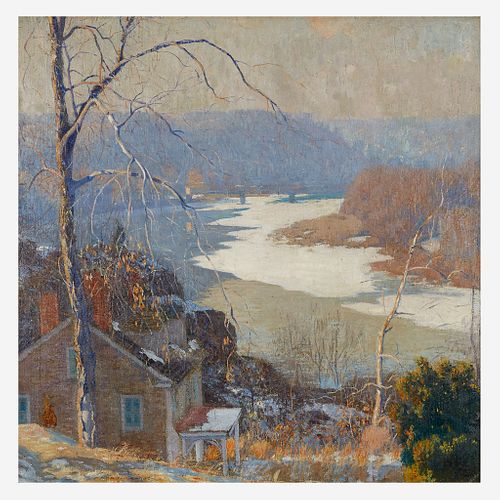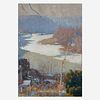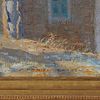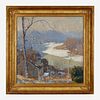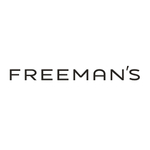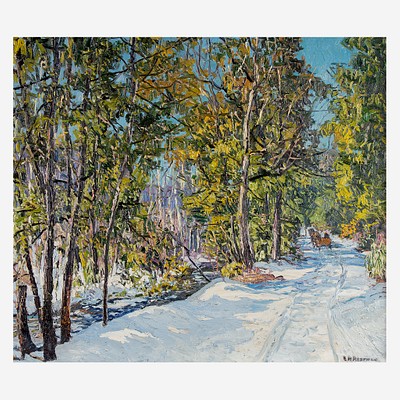Daniel Garber (American, 1880–1958) Up the River, Winter
About Seller
2400 Market St
Philadelphia, PA 19147
United States
Established in 1805, Freeman’s Auction House holds tradition close, with a progressive mind-set towards marketing and promotion, along with access to a team of top experts in the auction business. And now with offices in New England, the Southeast, and on the West Coast, it has never been easier to ...Read more
Two ways to bid:
- Leave a max absentee bid and the platform will bid on your behalf up to your maximum bid during the live auction.
- Bid live during the auction and your bids will be submitted real-time to the auctioneer.
Bid Increments
| Price | Bid Increment |
|---|---|
| $0 | $25 |
| $500 | $50 |
| $1,000 | $100 |
| $2,000 | $200 |
| $3,000 | $250 |
| $5,000 | $500 |
| $10,000 | $1,000 |
| $20,000 | $2,000 |
| $30,000 | $2,500 |
| $50,000 | $5,000 |
| $100,000 | $10,000 |
About Auction
Dec 5, 2021
Led by the esteemed Collection of Virginia and Stuart Peltz, Freeman's December 5 sale will feature marquee names of the field, from 19th century landscapists Albert Bierstadt and George Inness to Illustration Art masters like Stevan Dohanos and Jessie Willcox Smith. Freeman's info@freemansauction.com
- Lot Description
Daniel Garber (American, 1880–1958) Up the River, Winter
Signed '-DANIEL GARBER-' bottom center left, oil on canvas
30 x 30 in. (76.2 x 76.2cm)
Executed in January 1915.Provenance
The Artist.
Acquired directly from the above through E. J. Halow, Reading, Pennsylvania.
Collection of George Nye, Manistee, Michigan.
Collection of J. Bennett Nolan, Reading, Pennsylvania (before 1932).
Newman Galleries, Philadelphia, Pennsylvania (by 1962).
Collection of Stanley S. Snellenburg, Philadelphia, Pennsylvania (January 1964).
Newman Galleries, Philadelphia, Pennsylvania
Plymouth Meeting Gallery, Plymouth Meeting, Pennsylvania.
Acquired directly from the above in 1989.
Collection of Virginia and Stuart Peltz, Bucks County, Pennsylvania.
Footnote:Literature
Artist's Record Book I, lines 13-17, p. 13
Artist's Record Book II, p. 92.
Letter from J. Bennett Nolan to Daniel Garber, March 21, 1932.
Letter from Daniel Garber to J. Bennett Nolan, December 1, 1942
Letter from J. Bennett Nolan to Daniel Garber, April 20, 1953.
Lance Humphries, Daniel Garber: Catalogue Raisonné, Hollis Taggart Galleries, New York, 2006. Vol. II, p. 114, P 336 (illustrated).
Note
The paintings Daniel Garber produced during the 1920s often depict habitations and towns gently embraced and framed by nature, as exemplified by the present work. Up the River, Winter depicts an impressive, expansive view of the not-yet-frozen Delaware river from above Mary Taylor's cottage, a charming little house perched on the edge of the cliff in the direction of Lumberville. The artist seemed to enjoy this view as the house appears in other works such as The Old Farm, Springtime (1923), as well as November Snow (1923) and Quarry by Taylor's (date unknown).
Although Daniel Garber was not the only one to feature barns and houses in his landscapes, he was the first one to treat them as part of the narrative rather than just picturesque, accessory elements. As Lance Humphries points out however, "the artist's works from this period rarely tell a story in front of a bulilding; rather, it is the structure itself that tells the story." In the present work Humphries continues, a house "hunker[s] down into [its] snowy hillside, appearing to endure the winter in anticipation of summer when the trees that arch over [it] will shade and protect [it].
Traditionally seen as a painter of spring and summer, Garber here proves his ability to capture the so-distinctive winter light, and to represent the anatomy of the bare landscape. As the artist himself confessed: "The earth forms are very handsome in late autumn and winter; when the anatomy of the ground is so defined in beautifully toned planes of dead grass, exposed stone, and handsome lines and curves of the turf." Here, the leftover blotches of snow, slowly melting away, help enliven the scene and highlight its inherent structure. Captured in varying hues of white, blue and green, the snow also vivifies the contrast with the warmer surrounding colors, which are here to suggest the arrival of spring, and make the viewer aware of the passage of time. Through his exact capturing of a soft winter light on the rugged Pennsylvania landscape, Garber transcends an ordinary moment into an almost ethereal image. Similar to George Inness, he beautifully extracts from the spectacle of winter an elevating and ennobling experience in a somewhat melancholic, elegiac mood.
Condition report:Frame: 39 1/4 x 39 1/4 x 2 3/4 in.
The relined canvas in very good condition. With light stretcher bar mark running along the top outer edge of the work, and light craquelure at center; mostly located on the white ice on the river. With small crease/scruff in the canvas at bottom right corner. Examination under UV light does not reveal any restoration. Some of the pigments (notably the greys, but also some pinks and yellows) appear purplish under UV light: not inpainting.
- Shipping Info
-
No lot may be removed from Freeman’s premises until the buyer has paid in full the purchase price therefor including Buyer’s Premium or has satisfied such terms that Freeman’s, in its sole discretion, shall require. Subject to the foregoing, all Property shall be paid for and removed by the buyer at his/ her expense within ten (10) days of sale and, if not so removed, may be sold by Freeman’s, or sent by Freeman’s to a third-party storage facility, at the sole risk and charge of the buyer(s), and Freeman’s may prohibit the buyer from participating, directly or indirectly, as a bidder or buyer in any future sale or sales. In addition to other remedies available to Freeman’s by law, Freeman’s reserves the right to impose a late charge of 1.5% per month of the total purchase price on any balance remaining ten (10) days after the day of sale. If Property is not removed by the buyer within ten (10) days, a handling charge of 2% of the total purchase price per month from the tenth day after the sale until removal by the buyer shall be payable to Freeman’s by the buyer. Freeman’s will not be responsible for any loss, damage, theft, or otherwise responsible for any goods left in Freeman’s possession after ten (10) days. If the foregoing conditions or any applicable provisions of law are not complied with, in addition to other remedies available to Freeman’s and the Consignor (including without limitation the right to hold the buyer(s) liable for the bid price) Freeman’s, at its option, may either cancel the sale, retaining as liquidated damages all payments made by the buyer(s), or resell the property. In such event, the buyer(s) shall remain liable for any deficiency in the original purchase price and will also be responsible for all costs, including warehousing, the expense of the ultimate sale, and Freeman’s commission at its regular rates together with all related and incidental charges, including legal fees. Payment is a precondition to removal. Payment shall be by cash, certified check or similar bank draft, or any other method approved by Freeman’s. Checks will not be deemed to constitute payment until cleared. Any exceptions must be made upon Freeman’s written approval of credit prior to sale. In addition, a defaulting buyer will be deemed to have granted and assigned to Freeman’s, a continuing security interest of first priority in any property or money of, or owing to such buyer in Freeman’ possession, and Freeman’s may retain and apply such property or money as collateral security for the obligations due to Freeman’s. Freeman’s shall have all of the rights accorded a secured party under the Pennsylvania Uniform Commercial Code.
-
- Buyer's Premium



 EUR
EUR CAD
CAD AUD
AUD GBP
GBP MXN
MXN HKD
HKD CNY
CNY MYR
MYR SEK
SEK SGD
SGD CHF
CHF THB
THB